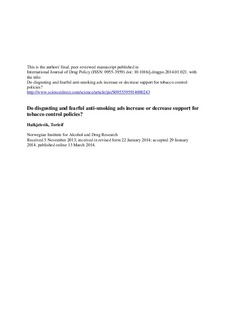| dc.contributor.author | Halkjelsvik, Torleif | |
| dc.date.accessioned | 2015-08-20T09:31:53Z | |
| dc.date.accessioned | 2015-08-21T08:55:50Z | |
| dc.date.available | 2015-08-20T09:31:53Z | |
| dc.date.available | 2015-08-21T08:55:50Z | |
| dc.date.issued | 2014 | |
| dc.identifier.citation | International journal of drug policy 2014, 25(4):744-747 | |
| dc.identifier.issn | 0955-3959 | |
| dc.identifier.uri | http://hdl.handle.net/11250/297698 | |
| dc.description | - | |
| dc.description.abstract | Abstract
BACKGROUND:
Frightening messages and disgusting pictures are commonly used in anti-smoking media campaigns. How does watching these campaigns affect people's attitudes towards tobacco control policies?
METHODS:
Non-smokers (n=464) and smokers (n=139) recruited through the online labour market Amazon Mechanical Turk watched anti-smoking videos with one of the three types of emotional content (random allocation): fear plus disgust, fear only (i.e., only moderate levels of disgust), or a control condition. Differences between the three conditions on a Tobacco Policy Support Index were tested after advertisement exposure. Potential mediation through ratings of negative emotions was determined with bootstrap tests of indirect effects.
RESULTS:
For non-smokers, videos that induced fear or fear in combination with disgust were associated with higher support for tobacco control policies than the control condition. The effect seemed to be mediated through ratings of fearfulness. Those who perceived the videos as fearful reported higher levels of support. For smokers, there was no overall effect of the videos.
CONCLUSION:
The data suggest that anti-smoking advertisements with strong negative emotional content can produce more support for tobacco control policies among non-smokers. | |
| dc.language.iso | eng | |
| dc.title | Do disgusting and fearful anti-smoking advertisements increase or decrease support for tobacco control policies? | |
| dc.type | Journal article | |
| dc.date.updated | 2015-08-20T09:31:53Z | |
| dc.identifier.doi | 10.1016/j.drugpo.2014.01.021 | |
| dc.identifier.cristin | 1125874 | |
